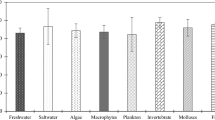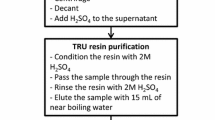Abstract
A method has been developed for the determination of113mCd from fallout in large-volume environmental water samples. In the analytical procedure a known amount of cadmium carrier is added to the sample and the cadmium is preconcentrated as insoluble hydroxide by coprecipitation with ferric hydroxide. The separated cadmium is purified from other interfering elements by an anion—exchange procedure. Finally, cadmium is coprecipitated with copper sulfide, and the radioactivity of113mCd is measured in a lowbackground, gas-flow proportional beta counter. The cadmium recovery is established by determining the amount of Cd in the precipitate using an energy dispersive x-ray fluorescence spectrometer. For a 24hr counting period a lower limit of detection around 50μBq113mCd/1 of sample has been attained. Samples of Lake Michigan water were analyzed: the concentration of113mCd in 1980 was 177±5 μBq/l.
Similar content being viewed by others
References
L. FRIBERG et al., Cadmium in the Environment, 2nd ed., Chemical Rubber Company Press, Cleveland, 1974.
Comparative Studies of Food and Environmental Contamination, Proceedings Series, IAEA, Vienna, 1974, p. 23, 159.
M. WEBB, (Ed.), The Chemistry. Biochemistry and Biology of Cadmium, Elsevier, New York, 1979.
United Nation Environmental Programme, The Environmental Impacts of Production and Use of Energy, Part I. Fossil Fuels, Energy Report Series I., Nairobi, 1974.
V. E. NOSHIKIN, K. M. WONG, R. J. EAGLE, D. L. ANGLIN, Nature, 287 (1980) 221.
V. E. NOSHKIN, K. M. WONG, R. J. EAGLE, D. L. ANGLIN, In: Impact of Radionuclides Release into the Marine Environment, Proceedings Series, IAEA, Vienna, 1981.
M. S. SHUMAN, W. W. FOGELMAN, J. Water. Poll. Contr., 49 (1977) 901.
M. J. FISHMAN, D. E. ERDTMANN, Anal. Chem., 51 (1979) 317R.
Standard Test Methods for Cadmium in Water, Annual Book of ASTM Standards, Part 31, Water, ASTM, Philadelphia, 1979.
M. S. TORREY, Environmental Status of the Lake Michigan, Vol. 3, Report ANL/ES-40. Argonne, 1976.
HASL Procedures Manual, Radiochemical Determination of Cadmium, USAEC, New York, 1972.
Procedures for Radiochemical Analysis of Nuclear Reactor Aqueous Solutions, Report EPA-R-4-73-014, Cincinnati, 1973.
J. DE VOE, Radiochemistry of Cadmium, USAEC Report NAS-NS-3001, New York, 1960.
R. P. LARSEN, G. T. TISUE, RER Division Annual Report ANL-75-60, Par III, 1975, Argonne, p. 51.
M. A. WAHLGREN, D. M. NELSON, RER Division Annual Report ANL-8060, Part III, Argonne, 1973, p. 85.
J. J. ALBERTS, M. A. WAHLGREN, Env. Sci. Tech., 15 (1981) 94.
H. E. ALLEN, K. E. NOLL, O. JAMJUN, C. BOONLAYANGOOR, RER Division Annual Report, ANL-77-65, Part III, Argonne, 1977, p. 70.
J. GARDINER, Water Res., 8 (1974) 157.
J. MUHLBEIER, G. T. TISUE Water, Air, Soil. Pollut., 15 (1981) 45.
I. M. KOLTHOFF, et al., (Eds), Treatise on Analytical Chemistry, Part III, Vol. 3, Interscience Publ. New York, 1961, p. 194.
Annual Environmental Operating Report, Part B, Radiological, Eberline Instrument Co., Midwest Facility, West Chicago, 1980. There have been reports of65Zn being present in Lake Michigan at concentrations which would constitute an interference in this analysis. These results are, however, very suspect. To maintain a65Zn concentration in Lake Michigan (volume=5·10151) that was equal to the113mCd concentration, 150μBq/1, would require that the discharge rate of65Zn from the power reactors adjacent to the lake be at least 3·1011 Bq/yr. Since for a particular reactor the annual discharge to the lake of all beta emitting nuclides other than tritium is limited to 4·1011 Bq, the actual discharge is an order of magnitude less than this (B. SCHRAMER, Commonwealth Edison Co., private communication) and the principle nuclides in the discharge are137Cs,134Cs and58Co, one must conclude that the reported65Zn value was in error and that none of the measured activity in the113mCd determinations was65Zn.
F. NELSON, K. A. KRAUS, J. Am. Chem. Soc., 76 (154) 5916.
Author information
Authors and Affiliations
Rights and permissions
About this article
Cite this article
Palágyi, Š., Larsen, R.P. Determination of113mCd in natural water. J. Radioanal. Chem. 80, 141–152 (1983). https://doi.org/10.1007/BF02517657
Received:
Issue Date:
DOI: https://doi.org/10.1007/BF02517657




